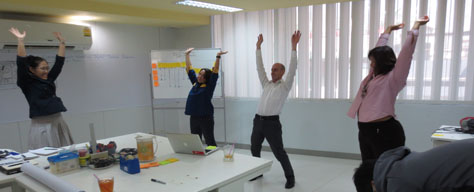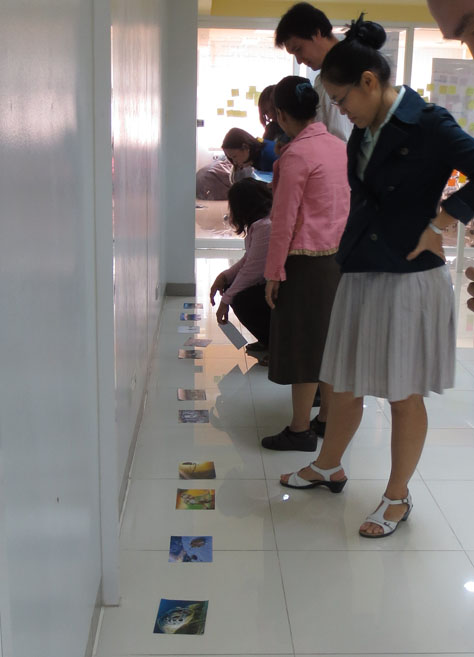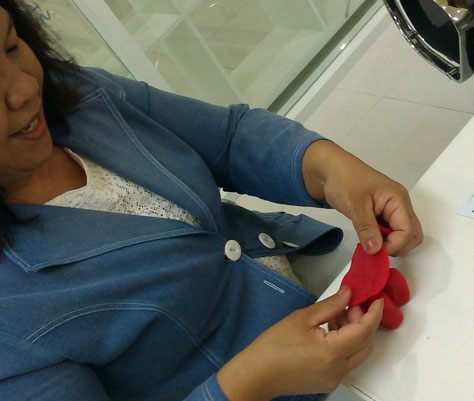In the Beginning
The workshop you elaborately prepared has officially begun. But, oh no! Attendees with all kinds of backgrounds, experiences, and expertise wander into the room like zombies. They lifelessly clutch their belongings close to their bodies, while looking for a seat in the shadows—as far away from the front of the room as possible. A few show at least some bravery by sitting up in front—but for most, only because that’s where their colleagues are sitting. They groan and fidget with their mobile phones. Their expressions and gestures say it all: “I really don’t want to be here!” or “When is lunch?”
You begin your meeting by going over the objectives, then answering questions like “When will this be over?” You can tell this is going to be a difficult two hours.
The Aftermath
Though cringing internally, you stand by the door, thanking everyone for their participation. (Was that really participation?) However, the reality of what just transpired is a bit alarming. For the most part, it was you who contributed the ideas. Some who did participate either subjectively criticized others’ ideas or dominated the discussion. Many didn’t even bother talking because they were afraid that others would judge them. The results were disappointing, and there was little progress to show. Was the entire workshop a waste of time?
You may have experienced bad workshops like this countless times. When leading your next workshop, you’ll need some help stopping the zombies from taking over! So, let’s look at what a warm-up activity is and how it can bring life into participants and the results of your workshop.
Keeping the Zombies at Bay with Warm-up Activities
Essentially, a warm-up activity is an introductory, participatory activity at the beginning of a workshop. Its purpose is to prime participants to think creatively and critically, while also setting the workshop’s tone and communicating your expectations for it.
The warm-up activity is the initial session that you’ll facilitate for your workshop’s participants and occurs before the workshop’s primary activities. It shouldn’t take up too much valuable time—from five to twenty minutes might be appropriate. Of course, this depends on how much time you’ve scheduled for your workshop, as well as the number of participants and their workshop experience, backgrounds, and even possible language barriers.
Recently, many of the workshops I’ve conducted have required an English translator, so I’ve had to dedicate more time to conducting warm-up activities. A rule of thumb: first-time activities usually take longer than you’ve planned. So it helps to allow some extra time when planning your agenda. If possible, you should have other team members watch the clock and help you to manage time, so you can focus on facilitation.
A great way to understand how long any workshop activity might actually take is to practice and rehearse beforehand. Grab your team members and have them do the activity. As you rehearse, pay attention to what parts of the activity are establishing a contextually relevant and engaging atmosphere and what parts are confusing participants, taking up too much time, causing participants to drift, or failing to encourage participation.
So when planning warm-up activities, be sure that they
- occur before your primary workshop activities
- do not take up too much valuable workshop time
- are meaningful and relevant to participants and the context of the workshop
- are as well prepared and rehearsed as any other workshop activity
Using Warm-up Activities to Change Behavior
Having a workshop with zombie participants wouldn’t lead to productive results. So let’s examine the behaviors we can expect to result form using an effective warm-up activity. Before a participatory workshop, you can use warm-up activities to change the behavior of participants by
- breaking down their protective shells and encouraging them to engage and interact socially
- providing opportunity for everyone to have an equal voice from the beginning
- priming participants to call on their experiences and think critically, creatively, and laterally
- adding a sense of thrill and excitement to the room’s atmosphere
Breaking Down People’s Protective Shells
Throughout my career, I’ve been fortunate to design and facilitate participatory workshops for my clients and team members in the US, Australia, and South East Asia, across distinct social and company cultures. But a common behavior that I notice in people who come to a participatory workshop for the first time is that they tend to be more passive and reluctant to participate. This may be because the workshop setting is completely new and unfamiliar to them, or they might be following company and even cultural norms and expect just to listen rather than speak, or they may be quiet because they fear being judged by other team members.
So, to counteract this passive and restrained behavior, I have come up with some rules and expectations that I communicate to everyone in the room. Participants practice fulfilling these expectations during the initial warm-up activity and continue to follow them throughout the entire workshop. Here’s what I tell participants.
Providing Everyone the Opportunity to Participate
There are several things that you can do to ensure that everyone has equal opportunity to participate in your warm-up activity.
Be Objective in Your Behavior Toward Others
We want our discussions, comments, and critiques to be relevant, valuable, and objective. Being objective ensures unbiased discussion, while providing participants a lens through which to look at an idea from multiple perspectives. The moment people subjectively critique other’s comments because of their biases or emotional attachment to their own opinions is when tensions arise, engagement dissipates, and communication breakdowns begin to form.
Ensure Everyone Is Equal
When joining the workshop, leave your title and status at the door. It’s not allowed in this room. Whether you’re the CEO, CTO, project manager, designer, or intern, everyone’s ideas and comments have equal weight. While an intern may have just begun working with the company, his or her life experiences are unique—very different from that of someone who’s been a CEO for 15 years—so an intern can contribute fresh ideas.
To deal with people who like to control conversations, I clearly state that the only person who is allowed to control the conversation is me—the facilitator.
Ask Everyone to Participate
There’s no sitting alone in a corner, hoping to not be noticed. [1] An easy way to encourage people to participate socially is to make your warm-up activities fun and quirky, yet relevant to their lives, past experiences, and the project. Usually, once a warm-up activity is over, I like to recall something interesting and relevant from everyone’s answers or ideas. This gives everyone a sense of confidence that their contribution was important.

Priming Participants to Contribute Good Ideas
Before you begin your workshop, be sure to explain to the group what a warm-up activity is, why it’s important, and what your rules and expectations are.
Okay, so now you have a room full of socially engaged, equal individuals who love sharing their ideas objectively. There are no longer any zombies in the room. Well, this sounds great! But you’ll need a bit more from participants if you want your workshop to yield productive results. You’ll need participants to collaborate and contribute great, thought-provoking ideas, not trivial, trite, meaningless, contextually irrelevant ones!
Great ideas come from a person’s unique experiences. But these experiences are embedded at different cognitive levels, so it can be challenging to access them. Some experiences and ideas surface easily through explicit communication—whether talking or writing. Other experiences and ideas relating to how we do things and make things are embedded at a deeper cognitive level, so require different activities to extract them.
In workshops that require participants to provide creative and critical thinking throughout, you must design activities that access all levels of their experiences. I recommend that you read Elizabeth Sanders’s article “From User-Centered to Participatory Design Approaches,”PDF![]() in which she describes in greater detail how to access different levels of experience by giving people Say, Do, and Make opportunities.
in which she describes in greater detail how to access different levels of experience by giving people Say, Do, and Make opportunities.
Providing Say, Do, and Make activities during a workshop is also a great way to encourage participants to think laterally rather than vertically. Vertical thinkers tend to think logically and sequentially. But this kind of thinking can constrain creative ideation. Lateral, outside-the-box thinking forces our minds to explore ideas creatively and establish connections between unrelated things.



